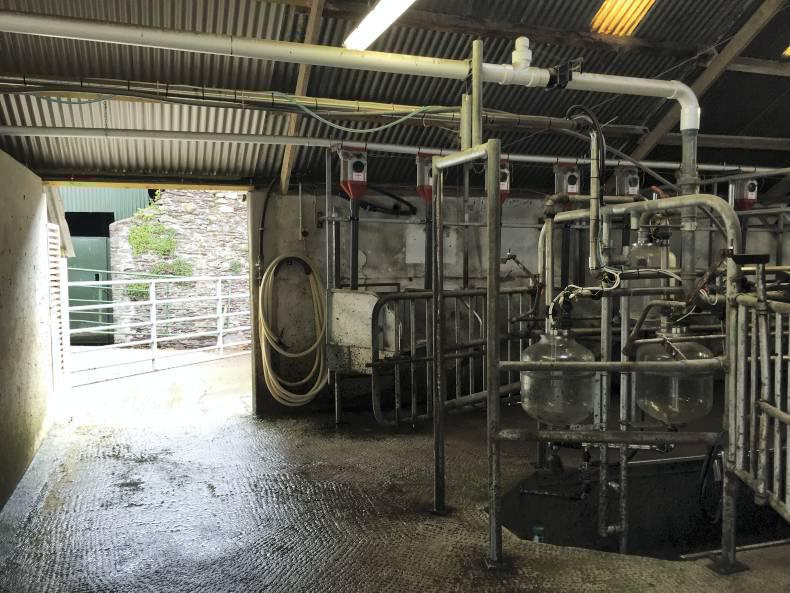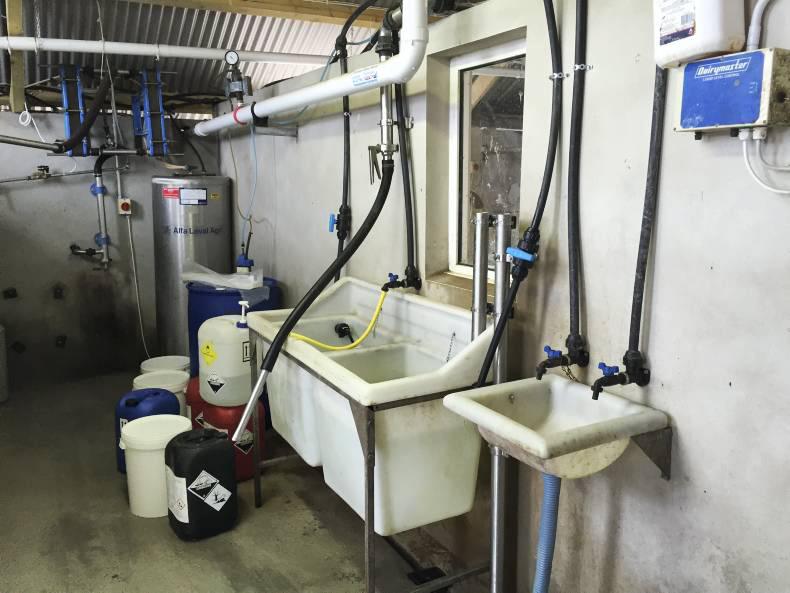In 2013, dairy farmer Shane Horgan began leasing a farm one mile from his home in Carrignavar, not far from Cork city. The farm in question belongs to the Missionaries of the Sacred Heart, who were renowned Holstein Friesian breeders but decided to exit farming in 2013. They continue to run Carrignavar College secondary school, which is adjacent to the farmyard.
One hundred and thirty cows are currently being milked on the 51ha block, but Shane and farm manager Kieran Sheehan intend to increase the number being milked over the coming years. There was a seven-unit double-up parlour on the farm when they moved in. This parlour had jars, but neither Shane nor Kieran enjoyed milking in it as it was taking too long.
With cow numbers increasing on Shane’s home farm, the 14-unit parlour there was coming under pressure, so last year Shane decided to upgrade and increase the parlour at home to a new 20 unit and move the old 14-unit Dairymaster parlour to the leased farm.

Browse the photo gallery above for more pictures
Work began in November last year when cows on both farms were fully dried off. The home farm was prioritised in terms of building work. Shane employed local builder Tom Coleman to oversee both parlours and he was helped by Shane, Kieran and Max, the farm worker on Shane’s home farm. Basically, Shane, Kieran and Max provided the labour – working under Tom’s direction.
The plan
The existing milking parlour in the college farm was a typical herringbone style. The cow standing was 2ft 6in and the dairy was to the front. Cows turned 90 degrees to exit the parlour, either to the left or the right.
The plan was to knock the dairy and double the length of the pit and add seven more units to make it into a 14-unit parlour and then install the milking parlour from home.
The first job was to demolish the front wall of the dairy and the wall separating the dairy from the parlour. After this, the existing parlour was dismantled. The old cow exits were blocked off and the digger was brought in to dig out the extension for the pit.
After concreting the pit and floors, the stall-work and plant from the home farm were transported on the back of a bale trailer from the home farm to the leased farm. Using loaders, props and rollers, the plant was carefully put in place. Because this is a leased farm, the stall work was bolted into the concrete, making it easier to remove again, if needs be.

After this, the next step was to construct the dairy. Luckily, there was plenty of room towards the front of the parlour for the dairy, so this was built there. The dairy wall was built 8ft back from the front gate in the parlour, giving plenty of space for cows to walk out. After three walls of the dairy were built and the floor laid, the next step was to install the bulk tank.
Again, in an effort to cut cost, Shane used his existing bulk tank from the home farm and purchased a larger one for there. This was an 8,000-litre Dari-Kool direct expansion tank and, when put in place, the final wall was built in the dairy, leaving space for a small door.
A small machine room was built to the side of the dairy to house the motors and pumps. The next step was to extend the roof over the new dairy. Again, cheap and cheerful was the order of the day: timber purlins and ordinary cladding. The final construction task was to get the walls plastered and Shane hired a local plasterer to do this.

The machine was commissioned by Willie McNamara, who was also installing Shane’s new Fullwood parlour on the home farm. Plumbing was carried out by Shane and the whole parlour was rewired by an electrician. Zig-zag feed troughs were already in the parlour, but the meal had to be bucketed into the troughs, so a new feed system was installed by IDS. The existing troughs remain but new ones were added, as was a new feed bin.
 See the table for a breakdown of the costs involved in converting the existing seven unit parlour to a 14-unit. Because the plant and bulk tank came from Shane’s home farm, an assumed cost of €10,000 was included for these. It’s hard to put an exact figure on what this is worth. Often, the bulk tank would be more saleable than the machine. The parlour is about 15 years old, with no cluster removers, meters or dump-line.
See the table for a breakdown of the costs involved in converting the existing seven unit parlour to a 14-unit. Because the plant and bulk tank came from Shane’s home farm, an assumed cost of €10,000 was included for these. It’s hard to put an exact figure on what this is worth. Often, the bulk tank would be more saleable than the machine. The parlour is about 15 years old, with no cluster removers, meters or dump-line.
As can be seen, total costs came to €40,585, excluding VAT, which is redeemable. What is not included in these costs is the labour. Shane says that between himself, Kieran and Max, at least 600 hours was spent working on the parlour on the leased farm. At a labour charge of €10/hour, this would add €6,000 to the cost of the project if the labour had to come from elsewhere, but because the cows were all dried off, it was a quiet time on the farm and they could afford to spend time working on the parlour in between feeding and other work.
Issues
Kieran, who does 90% of the milking in the parlour, is extremely happy about how it turned out as he can get all the cows milked in a little over an hour. Minor issues include a bit too much space in the cow standing area. In Shane’s new parlour, an adjustable breast rail was installed, which he moves in and out depending on the time of year.
The other small problem is a lack of drafting facilities. Normally, cows exit to the right, but if a cow is to be drafted she will go the left, where the crush is. This involves the milker standing at the front of the parlour ready to divert the cow he wants manually. This is time-consuming and, sometimes, the cows are slow to exit the parlour.
To summarise, what Shane and his team have put in place is an efficient parlour at low cost. For a total investment of €40,585, they have succeeded in keeping costs low. Most of the infrastructure from the old parlour was in place but, saying that, it serves as a timely reminder to those considering new builds what can be achieved by making alterations to existing facilities, at a fraction of the cost.
Read more from our special focus supplement on Dairy Equipment here.






 This is a subscriber-only article
This is a subscriber-only article
















SHARING OPTIONS: